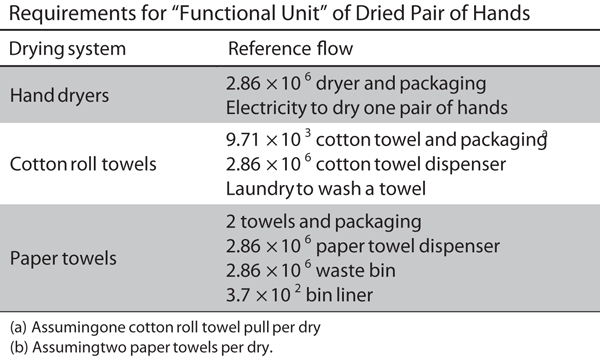Sustainable Hand Drying and Life-Cycle Assessment
Comparable LCA Data for Hand-Drying Systems
The results of the analysis have been the subject of some debate in an industry known for highly competitive and provocative claims. Yet most observers note that the study broke new ground, because the various LCA studies have never been compared against each other using rigorous statistical formulas.
In terms of green building design, the LCA analysis offers a cradle-to-grave analysis with all use-phase effects to understand the full, relative impacts of cloth, paper and electrical means. It includes all implied operational needs, including the dryer machine, towel dispensers, waste bins and bin liners, as well as packaging typically used. The impacts are allocated by assuming a five-year life span—mainly because electric dryers are typically warranted for five years—and a total life usage of 350,000 pairs of hands, or about 1,350 per week. In this way, the functional unit is defined as: 1/350,000, or 2.86 × 10-6 of the chosen drying method's total life-cycle impact.4
More assumptions need to be made to compare the drying methods. For example, trash or laundry bin liners—typically bags made of polyethylene or a biodegradable alternative material—can serve hundreds of pairs of hands but not all 350,000 uses. Bin liners for cotton rolls were set at 270 uses each, with 1/270 of a liner for each dry pair of hands; more are required for paper towels. On the other hand, cotton towels must be laundered, while paper towels do not have a washing impact.
In terms of transportation impact, the study assumes that all the drying systems are made in China and used in the United States, except for paper towels, which are primarily of domestic origin.
Upstream processes are also included in the analysis, say the authors. This is important, because the production of most dispensers and paper products is energy intensive. In one industry study,5 100 percent recycled paper towels are assumed to require about 40 percent of the embodied energy of virgin-source paper towels, estimated at 3.884 watts per paper towel. If two towels are used, the functional unit cost is 7.768 watts. Hand dryers, by comparison, may need only 2.9 watts total to produce a pair of dry hands—an energy savings of 63 percent over the five-year life of the systems.6 The use-phase assumption of two towels per dry—similar to the dry times for various electric dryers according to the NSF protocol P335—are important to an accurate estimate of the system LCA.
Impacts for the production phases, such as raw materials and manufacturing, seem to pale in comparison to the use-phase numbers over the five-year system lifetimes. In addition, the end-of-life scenarios are important but relatively minor. One key fact from an environmental standpoint is that recycling is uncommon for products used in America's 20 million away-from-home restrooms. “Since paper towels can use recycled content but are rarely recycled themselves,” write the MSL authors of Life-Cycle Assessment of Hand-Drying Systems, “they represent the final product of an open-loop recycling system.”
Yet by simply restating the disparate LCA data in terms of the functional unit, all of the impacts of hand-drying can be compared, allowing specifiers and building owners to make an informed and rigorous choice of restroom equipment.
 |
LCA studies have been compared side by side using ISO-based LCA methods to ensure a consistent basis of comparison. To compare the studies, they are analyzed to determine life-cycle impacts for a single “functional unit” – in this case, a single pair of dry hands.7 Source: Materials Systems Laboratory |
Addressing Real-World Uncertainty
The MSL analysis of various LCA studies for hand drying also includes a detailed sensitivity and uncertainty analysis, which helps reinforce confidence in stated LCA results. Commonly used for scientific experiments, an uncertainty analysis investigates variables used in observations and models to quantify the range of potential variance or ambiguity in the conclusions, according to Etienne de Rocquigny, author of Uncertainty in Industrial Practice (Wiley & Sons) and an assistant research director at Ecole Centrale Paris, an engineering school in France. For the LCA comparison, the uncertainty analysis helps describe how confidence in the results may be impacted by methodology or “confounding effects.”
This is contrasted with a sensitivity analysis, which employs statistical methods to show how a model—such as an LCA—may have uncertainties in output due to uncertainty in the model's input.
For MSL's hand dryer analysis, “the sensitivity analysis compares the GWP [global warming potential] results for all seven of the hand-drying systems under different scenarios. All the baseline assumptions are varied, one at a time, in order to test the robustness of the baseline scenario results and conclusions.”
In 86 percent of the scenarios explored, the high-speed, hands-in dryer machines were found to have the lowest GWP of all the high-speed types. Further, the GWP for hands-in, electric drying is lower than the GWP for all other drying systems considered in 98 percent of all scenarios—a very robust level of certainty. In addition, say the authors of Life-Cycle Assessment of Hand-Drying Systems, the differences in the GWP impacts are “statistically meaningful even when accounting for uncertainty in the data sets used to generate the results.”
In the GWP calculations chart above, the average (mean) assessed global warming potential is given shown by the purple bars; the standard deviation, or calculated range of uncertainty, is shown by a gray dimension line.









